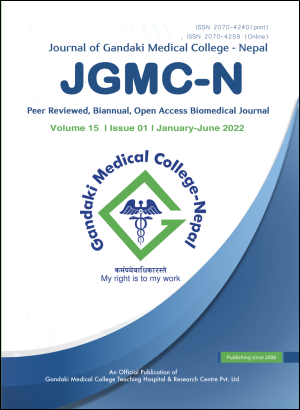Magnitude and pattern of combination traumatic dental injuries: An institution based retrospective study in Nepal
DOI:
https://doi.org/10.3126/jgmcn.v15i1.42219Keywords:
Traumatic dental Injuries, dental trauma, concurrent,, concomitant, combined fracture and luxation injuryAbstract
Introduction: Traumatic dental injuries can occur as combination injuries, where both fracture and luxation injuries occur concomitantly in the same tooth. The aim of this study was to evaluate prevalence of concomitant fracture and luxation injury (combination dental injuries) in permanent teeth.
Methods: A total of 455 traumatized anterior teeth from 175 patients (131 males and 44 females; age ranged from 14 to 70 years), coming for treatment of traumatic dental injuries over a five-year period from January 2016 to December 2020 were included in the study. Patient’s age and sex, type of injury, type and number of injured teeth were recorded from the clinical and radiographic examination records. Descriptive statistical methods were used for data analysis.
Results: A total of 257 teeth (56.48%) had fracture injury only, while 150 teeth (32.96%) were found to have luxation injury only. The most common isolated fracture injury was enamel-dentin fracture (n=93; 22.85%) and the most common isolated luxation injury was subluxation (n=77; 18.91%). A low prevalence of combination injury was observed in 48 teeth (10.54%). Enamel-dentin fracture (52.08%) was the most common fracture injury type presenting with a concomitant luxation injury. Similarly, the most frequent luxation injury type presenting with a concomitant crown fracture injury was subluxation (56.25%). The most common combination injury was enamel-dentin fracture in combination with subluxation injury (n=15; 31.25%).
Conclusions: The magnitude of combination injury was low in this study and was frequently observed in males of young age groups. The most common combination injury was enamel-dentin fracture in combination with subluxation injury.
Downloads
Downloads
Published
How to Cite
Issue
Section
License
Copyright (c) 2022 Sanjeeb Chaudhary

This work is licensed under a Creative Commons Attribution-NonCommercial 4.0 International License.
This license allows reusers to distribute, remix, adapt, and build upon the material in any medium or format for noncommercial purposes only, and only so long as attribution is given to the creator.




